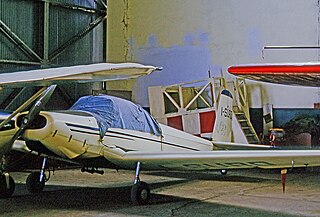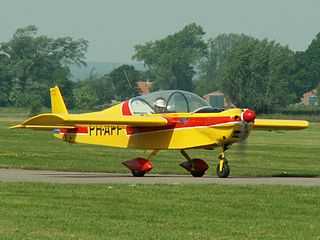
The Luton L.A.4 Minor was a 1930s British single-seat high-wing ultra-light aircraft. The prototype was built by the Luton Aircraft Limited, and design plans were later adapted and copies sold for homebuilding.

The Aviamilano P.19 Scricciolo was a light civil trainer aircraft built in Italy in the 1960s.

The Cassutt Special is a single-seat sport and racing aircraft designed in the United States in 1951 for Formula One air races. Plans are still available for homebuilding. Designed by ex-TWA captain Tom Cassutt, it is a mid-wing cantilever monoplane with fixed tailwheel undercarriage. The fuselage and tail are of fabric-covered steel tube construction, and the wings are built from plywood over wooden ribs. An updated taper-wing design was first flown in 1971 on Jim Wilson's "Plum Crazy".

The Cvjetkovic CA-65 Skyfly is a 1960s American homebuilt monoplane aircraft designed by Anton Cvjetkovic.
The Duruble Edelweiss is a light utility aircraft designed in France in the early 1960s and marketed for homebuilding. It is a low-wing cantilever monoplane with retractable tricycle undercarriage and all-metal construction. The aircraft was designed for a load factor of 9. Two- and four-seat versions were designed. The aircraft's creator, Roland Duruble flew the first example, a two-seater designated RD-02 in 1962, and in 1970 began to market plans for a stretched version with a rear bench seat as the RD-03. Over the next 15 years, 56 sets of plans had been sold, and at least nine Edelweisses finished and flown. In the 1980s, Duruble marketed an updated version of his original two-seater as the RD-02A, and sold around seven sets of plans, with at least one aircraft flying by 1985.

The Piel CP-30 Emeraude is an aircraft designed in France in the mid-1950s and widely built both by factories and homebuilders.
The DSK Airmotive DSK-1 Hawk was an unusual homebuilt aircraft designed in the United States in the early 1970s. While the design itself was utterly conventional - a single-seat low-wing cantilever monoplane with fixed tricycle undercarriage - its method of construction was not, since the DSK-1 Hawk used a surplus 200 US Gal military drop tank as its fuselage. Designer Richard Killingsworth sold over 250 sets of plans.

The Malmö MFI-10 Vipan was a four-seat light utility monoplane designed and built in Sweden by Malmö Flygindustri. Only three aircraft were built and the type did not enter quantity production.

The Piel CP.80 Zephir , Piel CP.801 and Piel CP.802 are racing aircraft developed in France in the 1970s and marketed for homebuilding. They are compact, single-seat, single-engine monoplanes with low, cantilever wings.
The Piel CP.90 Pinocchio II was a single-seat, single-engine aerobatic sport aircraft developed in France and marketed for homebuilding. The design was based on that of Piel's Emeraude and was unrelated to Piel's first design named Pinocchio, the CP.10 and indirectly to the second, the CP.20. It was a cantilever, low-wing monoplane of conventional design with an enclosed cockpit and fixed, tailwheel undercarriage. Construction was of wood throughout.

The Piel CP.60 Diamant is a single-engine light aircraft designed in France in the 1960s and marketed for home building.
The Piel CP.500 was a light aircraft of unusual configuration designed in France in the 1970s with the intention of marketing it for homebuilding. This did not transpire, however, and no prototype was actually built. It was a tandem wing design, somewhat reminiscent of the Mignet Pou-du-Ciel but considerably larger. Also, unlike the Pou-du-Ciel's unusual control system, the CP.500's pitch and roll control was to come from more conventional elevons mounted on the rear wing. The rear wing was also to carry endplate-style fins and rudders. Twin engines were to be mounted in push-pull fashion at the nose and tail ends of the fuselage, with the aircraft capable of single-engine operation in case of emergency. Two seats were to be provided at the front of the fully enclosed cabin, with a bench seat for three passengers behind them, plus an optional seat for a sixth occupant behind this. The undercarriage was to be of fixed, tricycle configuration. Construction was originally planned to be of wood, with engine cowlings and wingtips of composite construction. However, as development progressed, Piel considered metal as the main construction material.

The Pottier P.70 was a single-seat, single-engine sport aircraft developed in France in the 1970s and marketed for homebuilding. It was a mid-wing cantilever monoplane of conventional design with an enclosed cockpit. Originally designed with fixed, tricycle undercarriage, the plans were later revised to offer a fixed, tailwheel option. Construction throughout was of metal. A two-seat, tandem version was developed as the P.170.

The Rand Robinson KR-1 is a single-seat, single-engine sport aircraft designed in the United States in the early 1970s and marketed for homebuilding. A two-seat version is marketed as the KR-2. It is a low-wing cantilever monoplane of conventional design with an enclosed cockpit and tailwheel undercarriage. As originally designed, the main undercarriage units of the KR-1 and basic KR-2 were manually retractable, folding backwards into the wings, while the KR-2T tandem-seat version had fixed tricycle undercarriage. However, some builders choose fixed tailwheel or even fixed tricycle undercarriage for KR-1s and KR-2s.
The Piel CP-150 Onyx is a single-seat, low-cost and low-power ultralight aircraft. The aircraft was designed by French aeronautical engineer Claude Piel. The aircraft is an all-wood single seat microlight based on Mignet principles with fixed tricycle undercarriage and one 12 hp Solo engine.

The W.A.R. FW-190 is a half-scale homebuilt replica of a Focke-Wulf Fw 190 fighter. In July 1973, War Aircraft Replicas International of Santa Paula, California began design of an approximately half-scale replica of the Fw 190, the first of a series of replicas of World War II aircraft using similar constructional techniques. The first prototype made its maiden flight on 21 August 1974.

The Dyn'Aéro CR.100 is a French kit built single engine, two-seat monoplane, developed in the 1990s and intended as both an aerobatic trainer and a tourer, primarily for aero club use.
The Avid Aircraft Magnum is an American two-seat homebuilt cabin monoplane which was designed and sold as kits by Avid Aircraft of Caldwell, Idaho.

The Coupé-Aviation JC-01 is the first of a series of very similar designs of two seat, single engine sports aircraft, amateur built from plans in France from 1976. These provided a range of engine sizes and undercarriage layouts, but total production was small.
Marcel Jurca, was a prolific designer of homebuilt aircraft in France. He is most well known for his Tempête and Sirocco designs.














